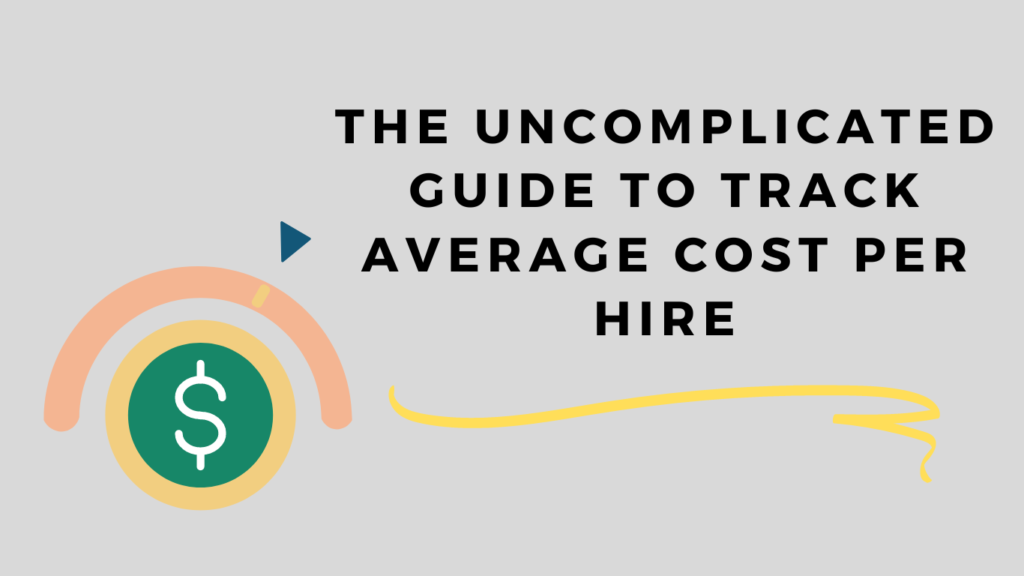Tracking Average Cost per Hire
Tracking the average cost per hire is a crucial aspect of any organization’s recruitment process. It refers to the total amount of money spent on recruitment divided by the number of new hires. Keeping track of this cost helps companies make informed decisions and optimize their recruitment strategies.
In this blog, we’ll dive into the importance of tracking the average cost per hire and how it can impact your organization’s bottom line. Are you curious about how tracking the average cost per hire can help you make better hiring decisions and save money? If so, keep reading! We’ll explore the benefits of monitoring this metric and provide tips on how to optimize your recruitment process.

Maybe, when you decided to open your own company you never thought you had to deal with all these metrics that when miscalculated, can make you lose money BIG TIME! That’s why we are here to uncomplicate one of these: average cost per hire.
What is the Cost Per Hire?
Cost per hire is a crucial metric for companies to understand the financial impact of their hiring process. It refers to the total expenses incurred by a company during the recruitment process for a single hire or multiple hires during a time frame. This includes costs related to:
- Job postings: This includes expenses related to advertising the job opening through various channels such as job boards, social media platforms, and recruitment agencies.
- Interviews: This includes costs such as travel costs for candidates, compensation for the interviewer’s time, and costs associated with any assessments or tests administered during the interview process.
- Background checks: These may include fees for accessing criminal records, credit reports, driving records, and verifying education and employment history. The cost can vary depending on the type and depth of the check required. Some employers may also choose to use third-party companies to conduct background checks, which can add to the overall cost.
- Onboarding activities: All costs associated with training, orientation, and administrative tasks such as setting up employee accounts and paperwork. Specific costs may include salaries for trainers or HR personnel and costs for training materials and technology.

This metric has become widely used in the HR industry, allowing companies to evaluate the effectiveness and efficiency of their recruitment efforts. By calculating the cost per hire, companies can identify areas where they can reduce expenses and optimize their hiring process.
What Are Recruiting Costs?
Recruiting is a complex and multifaceted process that involves various costs that must be taken into account when calculating the total cost per hire. These costs can be broadly categorized into two groups: internal and external costs.
- Internal costs refer to the expenses incurred by the company in the process of recruiting, which may include salaries and benefits paid to recruiters, advertising and marketing expenses, and the cost of conducting interviews and assessments of potential candidates.
- External costs, on the other hand, refer to the expenses incurred by the candidates themselves, such as travel expenses, relocation costs, and the cost of obtaining and submitting application materials.
However, not all of these costs are immediately apparent or easily quantifiable. For example, indirect costs such as lost productivity due to the time and effort expended on recruiting, as well as the potential impact on employee morale and retention, must also be taken into account.
Moreover, the costs of recruitment may be spread out over a longer time, depending on the length of the hiring process and the time it takes to onboard and train new employees. As such, companies need to take a comprehensive and strategic approach to recruiting costs to ensure that they are making informed decisions and maximizing the value of their investments.
The average cost per hire can range anywhere from $3,000 to $5,000
How Do You Calculate Your Average Cost Per Hire?
As we have told you above, calculating the average cost per hire is an essential metric for any organization that wants to measure its recruitment expenses. It provides deep insight into the cost of hiring new employees and can help identify areas where costs can be reduced. Here’s a step-by-step guide on how to calculate your average cost per hire.
Step 1: Determine the Total Recruitment Expenses
The first step is to calculate the total recruitment expenses incurred during the hiring process. These expenses may include job postings, recruitment agency fees, employee referral bonuses, travel expenses, and hiring manager salaries. Add up all these expenses to get the total recruitment expenses.
Remember to add internal and external costs!
Step 2: Determine the Number of Hires
The next step is to determine the number of hires made during the recruitment period. This number should include all the hires made through the recruitment process, including internal hires, external hires, and rehires.
Step 3: Calculate the Cost per Hire
Once you have determined the recruitment expenses and the number of hires, you can calculate the average cost per hire using the following formula:
Average cost per hire = Total Recruitment Expenses / Number of hires
For example, suppose that an organization spent $50,000 on recruitment expenses and made 10 hires. The average cost per hire would be $5,000 ($50,000 / 10). This means that the organization spent an average of $5,000 per new employee hired.

How Can You Use Cost Per Hire Results?
After knowing exactly how much it cost you to hire, what’s next? What if you found you are losing more money than you can afford? Let’s give you some guidelines!
Resource Allocation
Knowing your cost per hire can be incredibly useful in guiding resource allocation for recruiting. Once you have calculated your cost per hire, you can use this metric to compare your recruitment expenses to industry benchmarks or your own historical data. This can help you identify areas for improvement and optimize your recruitment processes to reduce costs and increase efficiency.
For example, if a company finds that their cost per hire is significantly lower for candidates sourced through employee referrals compared to those sourced through job boards, they may choose to allocate more resources towards employee referral programs. This can help the company save money on recruitment costs while also improving the quality of their hires.
Compare across Departments
Additionally, you can apply a cost per hire to specific departments or administration to gain insights into where your recruitment spending is most effective. For example, if the cost per hire is higher in one department than in others, it may indicate that the department needs to improve its recruitment and selection processes. Alternatively, it may suggest that the department is recruiting for more senior or specialized roles that require higher expenses.
However, it’s always safe to investigate why this is the case and see if there are ways to streamline their recruitment processes!
Compare across Industry
By comparing the cost-per-hire results across industries, organizations can get a better understanding of their recruitment expenses and how they stack up against their peers in the industry. This can help companies to identify areas where they may be overspending or underspending, and make adjustments to improve their recruitment strategies.
When comparing cost per hire across industries, it is important to consider factors such as the size of the company, the type of position being filled, and the geographic location of the organization. For example, the cost per hire for a high-level executive position in a large metropolitan area may be significantly higher than the cost per hire for an entry-level position in a smaller town.
Cost Per Hire and Employee Retention
A bad hire can cost a company around 50% to 150% of the employee’s salary, taking up to 9 months for a company to find a replacement.
The cost per hire is directly impacted by employee retention and engagement because high levels of turnover and low engagement can lead to a constant need for new hires, driving up recruitment costs. On the other hand, organizations that invest in retaining and engaging their employees can reduce their cost per hire by lowering the need for new hires and increasing the likelihood of employee referrals.
Therefore, organizations that prioritize employee retention and engagement tend to have lower costs per hire, which can positively impact their bottom line.
Other Important Company Metrics to Measure
When it comes to measuring the success of a company’s recruitment efforts, cost per hire is certainly an important metric. However, there are many other factors that companies should consider when tracking their hiring performance. By paying attention to these additional metrics, companies can gain a more holistic understanding of their recruitment process and make more informed decisions about how to optimize it.
Let’s review them!
- Time to fill: This measures the length of time it takes for a job opening to be filled, from the moment the position is posted to the moment an offer is accepted. A shorter time to fill can be an indicator of a strong recruitment process, as it suggests that the company is able to quickly identify and attract qualified candidates.
- Candidate experience: How satisfied are job candidates with the recruitment process? Tracking this metric can help companies identify areas for improvement and ensure that they are providing a positive candidate experience.
- Diversity and inclusion: Are the company’s recruitment efforts resulting in a diverse and inclusive workforce? Measuring the diversity of new hires and tracking progress over time can help companies ensure that they are creating an equitable workplace.
- Quality of hire: Are new hires performing well and meeting the company’s expectations? Tracking employee performance metrics, such as retention rates and productivity, can give companies insights into the quality of their hiring decisions.
In addition to these metrics, companies can also track their recruitment marketing efforts by monitoring metrics such as:
- Candidate sources: Where are the company’s most successful hires coming from? Tracking candidate sources can help companies identify which recruitment channels are most effective.
- Cost per applicant: How much does it cost the company to attract each job applicant? This metric can help companies optimize their recruitment marketing spend and identify areas where they can reduce costs.
- Social media engagement: Are the company’s social media posts and job ads generating engagement and interest from potential candidates? Tracking social media engagement can help companies refine their social media strategy and improve their recruitment marketing efforts.
While the cost per hire is an important metric for companies to measure, it is just one piece of the puzzle. By tracking additional metrics such as the ones mentioned above, companies can gain a more complete understanding of their recruitment process and make data-driven decisions to optimize it.
When to Calculate Cost Per Hire?
Generally, the best time to measure cost per hire is after the recruitment process is complete, and the new hire has started working. This allows the company to gather all the necessary data, including advertising costs, recruiter fees, and any other expenses related to the hiring process.
The time frame for calculating cost per hire depends on the company’s needs and requirements. Some companies may calculate the cost per hire on a monthly or quarterly basis, while others may do it annually. The frequency of calculating cost per hire may also depend on the industry. For example, industries with high turnover rates may calculate cost per hire more frequently than those with lower turnover rates.
Takeaway
By understanding the expenses associated with the hiring process, companies can make informed decisions that contribute to the success of their business. From determining the effectiveness of recruiting strategies to identifying areas where costs can be reduced, this knowledge is essential to keeping the company ROI positive and thriving.
As usual, we invite you to use the information provided in this blog post wisely. By analyzing your company’s hiring costs and making strategic adjustments, you can optimize your recruitment process and achieve better results. Don’t wait any longer to take action – start tracking your cost per hire today and reap the benefits of a more efficient and effective hiring process.
-The Monitask Team


